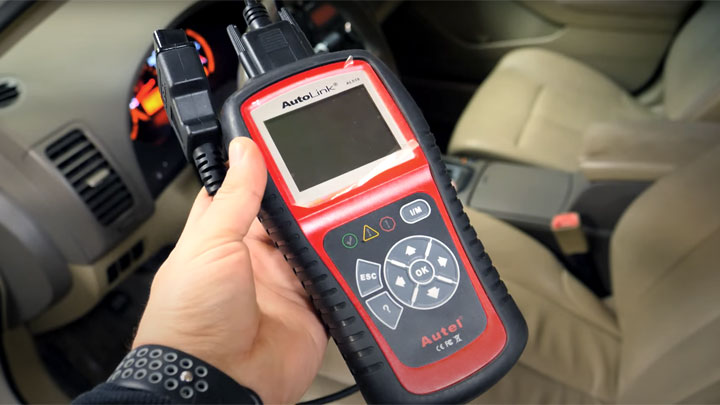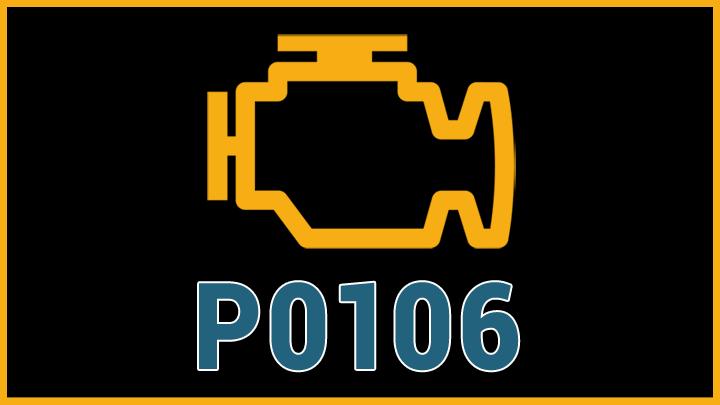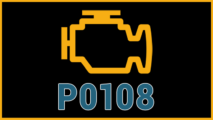Last Updated on January 17, 2022
The P0106 code indicates that the manifold absolute pressure (MAP) sensor has been triggered. This sensor problem is common in cars with high mileage (100,000 miles or more).
The MAP sensor controls a broad range of systems in your vehicle. If it’s faulty, the engine won’t run right, and it can cause serious drivability issues.
Most importantly, a malfunctioning MAP sensor indicated by the P0106 code can cause engine backfires. Luckily, there are several easy steps to diagnose and repair this issue. Let’s get started.
What Does Code P0106 Mean?
The P0106 error comes up on the power control module (PCM), which controls the car’s performance.
The PCM uses data from various sensors—the MAP being an important one of those. The MAP sensor measures engine load as well as the air-to-fuel ratio in the car. If this air to fuel ratio is off, the engine will either consume too much fuel or underperform.
A normal MAP sensor should read the manifold pressure as 1 to 4.5 volts. When this ratio is off, it can lead to misfires in the engine.
The manifold pressure naturally changes based on the throttle position, but when it fluctuates dramatically, the P0106 code is triggered. Other trouble codes tied to the MAP sensor are P0105, P0107, P0108, and P0109.
Symptoms of Code P0106

There are various symptoms of code P0106. However, the most indicative ones are the car burning more fuel than usual and the engine stuttering or running roughly.
Other possible symptoms include:
- Check engine light is on
- Engine misfires/backfires
- Air-to-fuel ratio too rich
- Engine stuttering while accelerating
- Excessive smoke in the exhaust
- Rough idle
Causes of Code P0106

In addition to the various symptoms, many different issues can cause a car to throw code P0106. It’s just as likely that the cause could be faulty wires as the MAP sensor being damaged.
- Cracked intake hose or faulty clamps on intake hose (most common)
- Faulty MAP sensor
- Damaged wiring of the MAP sensor
- Water or debris in the MAP sensor
- Open/Short in the MAP sensor wire
- Faulty PCM (least common)
- Leaks in the air intake system
Is Code P0106 Serious?
It’s important to note that Code P0106 is a serious error that should not be taken lightly. Problems with the MAP sensor can:
- Cause the throttle to malfunction
- Lead to misfires
- Damage your engine
You shouldn’t drive the vehicle until the P0106 code is resolved.
How to Fix

Because there can be multiple causes of the P0106 code, it’s important to make a thorough diagnosis before replacing the MAP sensor.
Start with the easiest test—visually checking the wiring and hoses around the MAP sensor. Then, move on to the full diagnosis of the MAP sensor.
Tools You’ll Need:
- OBD2 scan tool (what we recommend)
- Voltmeter
- Vacuum Pump
What To Do:
- Check for other trouble codes and scan the freeze frame data. Clear the engine check light.
- Visually check the air intake hose and intake duct for leaks or cracks. Make sure they are tight and that no clamps are missing.
- Turn on the ignition but don’t start your vehicle.
- Use an OBD2 scan tool to check the MAP sensor data. The pressure sensor should drop from 4.5 volts to about 1 volt. If it doesn’t, there is a problem with the wiring or the sensor.
- Use the vacuum pump to test the MAP sensor. Apply 20 inches of vacuum pressure without turning the engine on. If the voltage doesn’t drop, check the port and hose for clogs of debris. Clean them and, if necessary, replace them.
- Using a digital multimeter, check the wiring around the MAP sensor. Touch the multimeter wire to the MAP sensor. If you don’t get a reading of 5 volts, connect the wire to the PCM. If you’re getting voltage from the connection but not from the wire, inspect for shorts.
After running these diagnostics, it’s time to fix the P0106 Code error.
- Manually check that the wiring isn’t damaged, and the host and clamps are tight and fitted.
- Next, replace damaged wires, then clear the codes, and do a test drive to see if the P0106 code comes back.
- Remove and clean the MAP sensor with an electronic parts cleaner.
- Clean corrosion on the engine ground, if there is any, with automotive corrosion cleaner.
- If the code won’t clear after these steps, you’ll have to replace the MAP sensor.
It’s important to go through all these diagnostic steps before replacing the MAP sensor. That should be the last-resort option because it may not fix the problem if the wires are faulty.
After each step, be sure to test drive the car to check if the P0106 code has been cleared. If you go through all these steps and the code remains, go to a mechanic.




Thanks for the explanation is super
I have a 08 f150 I’m getting po106 and po 2198 and po2196 code. I have changed o2 ,maf, vacuum leaks, wiring.put new cats on l don’t know what else to do
Is the car running rich? I think you’ll have to have it professionally diagnosed to someone chase down the problem, sounds like a fueling issue maybe but it could be electrical.
I have a camaro 2017 ss
And I get this codes
P0106 status permanent
P0068 status permanent
P0300 status permanent
I replace the spark plugs coils
Throttle body and maf sensor waiting for map sensor to deliver for replacement too any ideas
This codes r saying permanent because r already storage I’m the ECU I’m gonna need to calibrate or reprogram the ECU with the right values?
Please if u can tell me what I have to do I will appreciate everything start after a serpentine belt broke
Inspect the engine bay for damage from the broken serpentine belt. Could the belt have damaged any nearby wiring?
I have a P0106 code on my 15 GMC Yukon Denali XL 6.2l. I have replaced the map sensor, the purge valve, the o2 sensors, the catalytic converter and the pvv valve. I taken my Yukon to the local GMC Deal for a diagnostic test, but they said to start with the map sensor. I replaced all the part and still my Yukon have a rough idle, shaking and sounds like an exhausting leak…
Did you replace the MAP sensor?
Did you find the problem? I’m dealing with the same thing in my 2015 Escalade